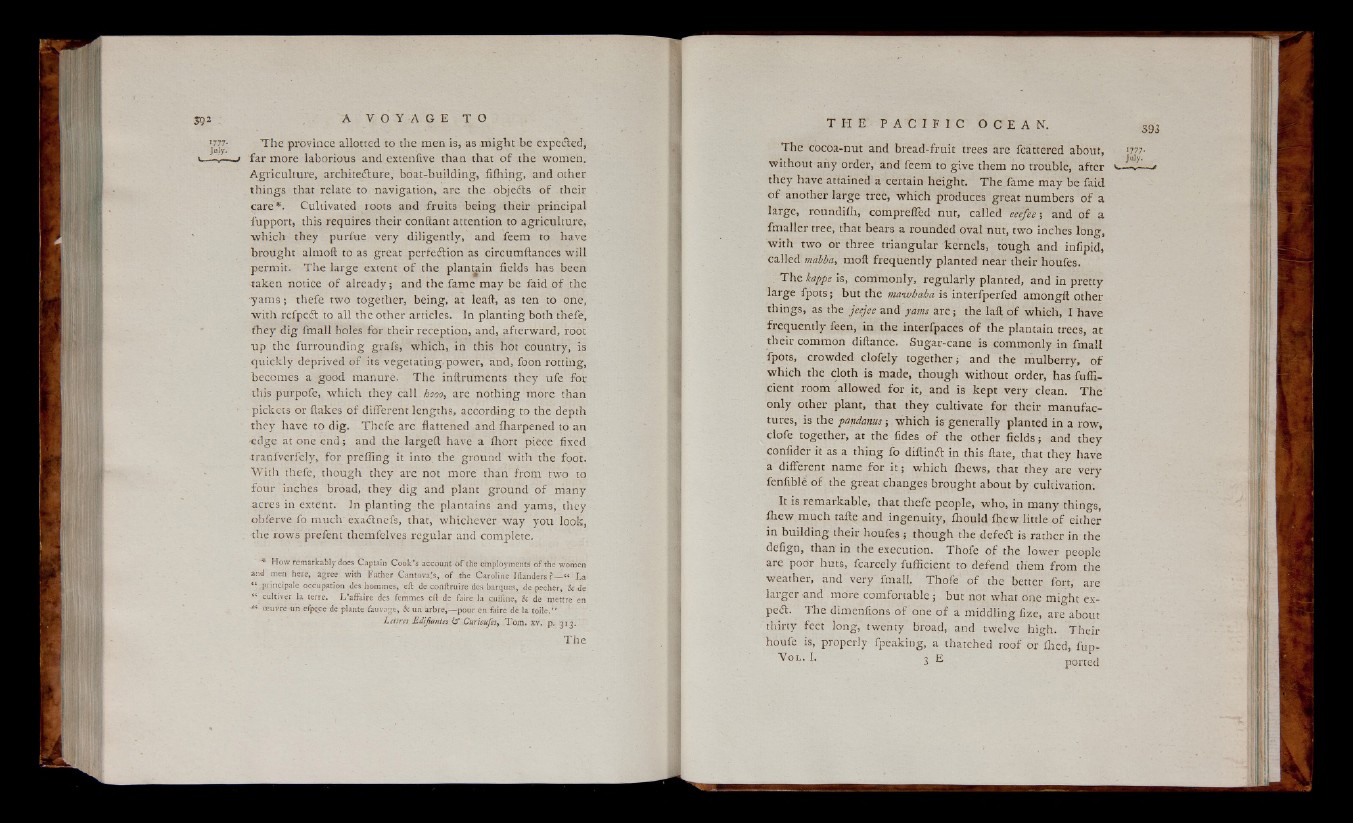
The province allotted to the men is, as might be expedited,
far more laborious and exteniive than that of the women.
Agriculture, architecture, boat-building, billing, and other
things that relate to navigation, are the objects of their
care*. Cultivated roots and fruits being their principal
fupport, this requires their conilant attention to agriculture,
which they purfue very diligently, and feem to have
brought almoft to as great perfeition as circumftances will
permit. The large extent of the plantain fields has been
taken notice of already; and the fame may be faid of the
yams; thefe two together, being, at leaf!, as ten to one,
with refpedt to all the other articles. In planting both thefe,
they dig fmall holes for their reception, and, afterward, root
up the furrounding grafs, which, in this hot country, is
quickly deprived of its vegetating, power, and, foon rotting,
becomes a good manure. The inftruments they ufe for
this purpofe, which they call haoo, are nothing more than
pickets or flakes of different lengths, according to the depth
they have to dig. Thefe are flattened and iharpened to an
edge at one end; and the larged have a fhort piece fixed
tranfverfely, for prefling it into, the ground with the foot.
With thefe, though they are not more than from two to
four inches broad, they dig and plant ground of many
acres in extent. In planting the plantains and yams, they
obferve fo much exadtnefs, that, whichever way you look,
-the rows prefent themfelves regular and complete.
' How remarkably does Captain Cook’s account-of the employments of the women
and men here, agree with Father Cantovals, o f the Caroline Iflanders ?— “ La
§j pt jncipale occupation ties hommes, eft de conftruire des barques, de pecher, & de
“ eultiver la terre. L ’affaire des femmes eft de faire. la cuiiine, & de mettre en
i f oeuvre -un efpqce de plante fauvage, & un arbre,— pour en faire de la toile.’ ’
Letlres Edifiantes £3* Curieufes, Tom. xv. p. 313.
The cocoa-nut and bread-fruit trees are fcattered about, 'in-
without any order, and feem to give them no trouble, after v—5®—■»
they have attained a certain height. The fame may be faid
o f another large tree, which produces great numbers of a
large, roundiih, comprefled nut, called eeefee; and of a
fmaller tree, that bears a rounded oval nut, two inches long,
with two or three triangular kernels, tough and infipid,
called mabba, moft frequently planted near their houfes.
The kappe is, commonly, regularly planted, and in pretty
large fpots; but the mawhaha is interfperfed amongft other
things, as the jecjee and yams are; the laft of which, I have
frequently feen, in the interfpaces of the plantain trees, at
their common diftance. Sugar-cane is commonly in fmall
fpots, crowded clofely together; and the mulberry, of
which the cloth is made, though without order, has fuffi-
cient room allowed for it, and is kept very clean. The
only other plant, that they cultivate for their manufactures,
is the pandanus; which is generally planted in a row,
clofe together, at the fides of the other fields; and they
confider it as a thing fo diftintft in this ftate, that they have
a different name for i t ; which ihews, that they are very
fenfible of the great changes brought about by cultivation'.
It is remarkable, that thefe people, who, in many things,
Ihew much tafte and ingenuity, fliould fhew little of either
in building their houfes ; though the defedi is rather in the
defign, than in the execution. Thofe of the lower people
are poor huts, fcarcely fufficient to defend them from the
weather, and very fmall. Thofe of the better fort, are
larger and more comfortable ; but not what one might ex-
pedl. The dimenfions of one of a middling fize, are about
thirty feet long, twenty broad, and twelve high. Their
houfe is, properly fpeaking, a thatched roof or ihed, fup-
VoL’ 3 E ported